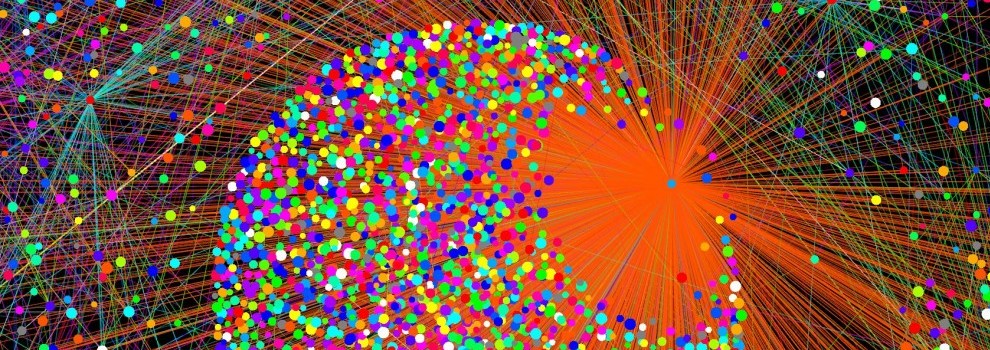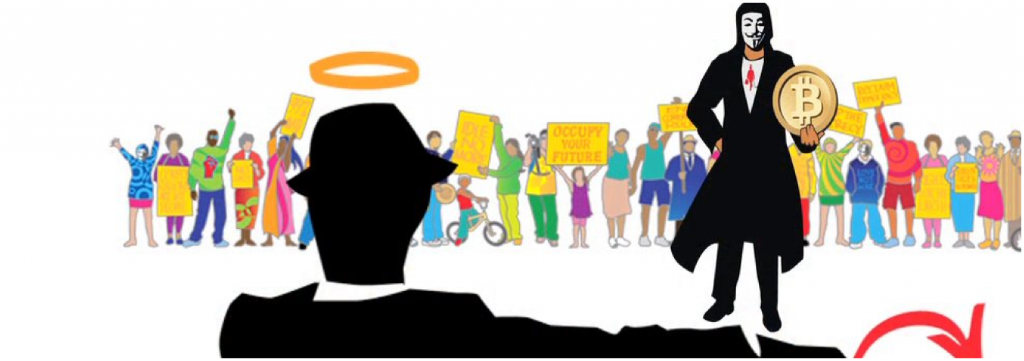There is one thing stronger than all the armies in the world, and that is an idea whose time has come.
– Victor Hugo. French poet and writer. 1802 – 1885
Historians may look back on these current days with fascination. We may be living through the beginning of one of the biggest paradigm shifts in modern human history. The way the world actually thinks about money and stored value might be changing in a tidal wave of recognition. This article will define what a paradigm is and what a paradigm shift looks like. Perhaps we may understand how to prepare and perhaps benefit from the embryonic beginnings of what may one day be seen as a titanic shift. The idea sparking this sea of change came from humble beginnings but has spread like wildfire accompanied by the necessary controversy one might expect from a monumental paradigm shift of understanding. One may seek learning opportunities from a rich history of previous major paradigm shifts and ponder the reasons for why some people flourished while others withered. As the cycles of paradigm shifts are recognizable and repeatable, this article intends to bring new understanding and context to the events now taking place. Those with the early grasp may draw from the lessons in history to prepare and anticipate the events as they unfold and perhaps discover an opportunity for profit.
What is a paradigm?
In effort to understand the world and events surrounding us, humans classify and categorize their own version of reality into a framework of reality we refer to as a paradigm, also known as a model. We draw ’cause and effect’ relationships and begin to correlate groups of related information into patterns to bring understanding to our lives. In the discipline of science it has become known as the Scientific Model. Over time, cultures, trade groups, religions, etc. will espouse teaching that view and establish a consensus for a view of reality. This can sometimes lead to rivalries between different camps interpreting the world in different ways. This process runs the risk of reinforcing incorrect judgement and opinions that can side-track generations and go unnoticed because of the negative pile-on effects of groupthink. The human natural tendency is to form into a hierarchy whose leaders determine “the official line” for the group. Once this is established, any person, or observable fact which might throw into question the belief of the paradigm will be seen as irrelevant, or even willfully ignored in their group. One’s paradigm becomes the lens from where they view the world. Observation of the same data may be interpreted vastly different depending on the lens of those viewing it.  The portrait above has been used in case studies about perception including research included in Stephen R Covey’s bestselling reference book “Seven Habits of Highly Effective People”. The first classroom students were were told to see the portrait of a young woman, after which the picture above was shown to them for a few seconds. Then another group of people were separately told beforehand about the portrait of an old lady facing to the left. They too were allowed to view the picture for only a few seconds. Through simple power of suggestion, the definition of which figure they should find was already given to them. This act gave them bias – to only find and agree to what they were told they were seeing. When they were finally allowed to gather as one group, each group was instructed to explain to the other group who the picture represented. Except for a few exceptions, many disagreements broke out, sometimes loudly, as each camp was convinced they alone were correct. This example showed the dramatic difference people defend over only a difference of opinion created in just a few seconds. Covey went on to explain how we don’t see the world how it is in reality, but how we see ourselves projected into the world. We also project our backgrounds, education and customs into the paradigm and expect those around us will see the same thing.
The portrait above has been used in case studies about perception including research included in Stephen R Covey’s bestselling reference book “Seven Habits of Highly Effective People”. The first classroom students were were told to see the portrait of a young woman, after which the picture above was shown to them for a few seconds. Then another group of people were separately told beforehand about the portrait of an old lady facing to the left. They too were allowed to view the picture for only a few seconds. Through simple power of suggestion, the definition of which figure they should find was already given to them. This act gave them bias – to only find and agree to what they were told they were seeing. When they were finally allowed to gather as one group, each group was instructed to explain to the other group who the picture represented. Except for a few exceptions, many disagreements broke out, sometimes loudly, as each camp was convinced they alone were correct. This example showed the dramatic difference people defend over only a difference of opinion created in just a few seconds. Covey went on to explain how we don’t see the world how it is in reality, but how we see ourselves projected into the world. We also project our backgrounds, education and customs into the paradigm and expect those around us will see the same thing.
What is a paradigm shift?
Thomas S. Kuhn, a noted scientist and author discovered a startling pattern that showed all of major scientific and technological breakthroughs don’t happen on a predictable linear scale as was previously assumed. They happen with sudden insights, explosion of thought and eureka moments. He challenged the entire scientific discovery process in his highly influential landmark book entitled “The Structure of Scientific Revolutions”, which was originally printed in 1962. The ideas espoused in this book triggered a worldwide reassessment which took into account several scholarly fields such as history, philosophy, sociology, and scientific knowledge. Paradigm shifts tear down the established models and completely rewrite the rules. These shifts are often unbelievable to the establishment at the top hierarchy of the previous model. The pattern emerges showing many of those leaders nearest the top of the hierarchy, who also have the most to lose in a paradigm shift, tend to fight the changes the most.
All the significant breakthroughs were “BREAK-WITHs” old ways of thinking.
–Thomas Kubn. author of “The Structure of Scientific Revolutions”
Thomas Kuhn’s work with Structure of Scientific Revolutions outlined five major phases of a paradigm change. For the purposes of this article, we substitute the term “scientific” to mean economic, or monetary theory. This article goes on to give scenarios of how these phases might be applied to the paradigm change bitcoin is filling.
1. Pre-paradigm period. Economic data is available but unorganized. There is little cohesion or organization for value for trade. Stateless bartering is the norm. Few records are kept and simple currencies are created.
2. Normal science. Data is gathered into patterns which can be predictable and repeatable. Trends emerge. Cause and effect are demonstrated. The first paradigm is created and general understanding among ‘experts’ is agreed. Schools of economic theory are formed. Governmental economic planning and central bank policy guidance begin to enforce.
3. Model Drift. Basic belief and understandings of the model begin to break down. Unemployment numbers rise, banks begin to fail. The law of unintended consequences result when overly broad central decisions are made for complex systems. Today, government economic experts make regular ad-hoc adjustments for headline reports including the calculation of inflation and the method of which to calculate unemployment. They change the underlying definitions to make the data match the results rather than measuring data and coming up with different theories or models. This results in a patchwork of quiet adjustments in attempt to keep the current paradigm relevant. Yet it continues to drift.  4. Period of Crisis. Breakdowns in predictive models happen. In economics and currencies – we see unpredicted anomalies. Hyperinflation, financial bubbles, housing crashes, rising unemployment, and government budget shortfalls are all unexpected consequences resulting in a growing sense of something being fundamentally wrong. Without this necessary crisis phase there may not be need to evaluate and recognize that a new paradigm is even possible. 5. Revolution. One paradigm is replaced by another believed to be better or more accurate. There will be “teams” that develop and divisions into their own camps that may be so different that they can’t agree even on the language terms and lens from which they view and speak of the data. In past paradigm changes there was little neutral ground to be found. Perhaps the concept of a complimentary currency system that combined current national currencies with a digital currency that is nation-less and trust-less and a strict creation limit will be favored. The unemployed, unbanked, and underrepresented population living in the margins of society see their hand held currencies becoming increasingly worthless. While the money printing press just keeps pumping out more of the same, the new paradigm needs might reach a tipping point. At one point, critical mass may develop and the floodgates open to people ‘opting in” to the new paradigm. People may simply ignore the old one as it becomes irrelevant. There aren’t many weeping over the loss of dial up modems to connect to the internet.
4. Period of Crisis. Breakdowns in predictive models happen. In economics and currencies – we see unpredicted anomalies. Hyperinflation, financial bubbles, housing crashes, rising unemployment, and government budget shortfalls are all unexpected consequences resulting in a growing sense of something being fundamentally wrong. Without this necessary crisis phase there may not be need to evaluate and recognize that a new paradigm is even possible. 5. Revolution. One paradigm is replaced by another believed to be better or more accurate. There will be “teams” that develop and divisions into their own camps that may be so different that they can’t agree even on the language terms and lens from which they view and speak of the data. In past paradigm changes there was little neutral ground to be found. Perhaps the concept of a complimentary currency system that combined current national currencies with a digital currency that is nation-less and trust-less and a strict creation limit will be favored. The unemployed, unbanked, and underrepresented population living in the margins of society see their hand held currencies becoming increasingly worthless. While the money printing press just keeps pumping out more of the same, the new paradigm needs might reach a tipping point. At one point, critical mass may develop and the floodgates open to people ‘opting in” to the new paradigm. People may simply ignore the old one as it becomes irrelevant. There aren’t many weeping over the loss of dial up modems to connect to the internet.
What does this have to do with bitcoin?
In many ways bitcoin is a complete break with the old ways. The fundamental principles are vastly different. It is a break with previous paradigms and rewrites money creation, protection, transfer, record keeping, validation, trust, privacy, and nation-created monopoly function. Many times throughout history it takes a crisis to completely motivate people to move from one paradigm to the other. With worldwide record deficits and money printing happening globally show we are in unprecedented times with the old paradigm of economics. New money is pushed to the banks without customer demand for it so banks invest it in alternative non productive places and segment bubbles form. When these bubbles eventually pop, the central banks take no responsibility for the ensuing trauma that displaces jobs and homes. In the world’s largest single economy, the US money printing continues to accelerate while record budget shortfalls and unprecedented levels of debt and politicians and officials can’t balance the budget. Even new all-time highs in tax collection can’t keep up with spending in the US. Nobody seems to know or can predict how this will end on a global level. We’ve seen this happen ad infinitum from countries ruining their economies and their citizens’ life-savings through hyperinflation and retirement confiscation. One might ask if we’ve already begun the crisis phase where one perception of reality literally falls apart and the other opposing paradigm wins by default? This cycle for the scenario plays out repeatedly in history – as Thomas Kuhn indicates in his book, citing several examples.
Money creation – as a currency
Old Paradigm: Created by central banks and lent to their respective governments based on supply and demand. It requires trust in the government to get it right to know how much currency is needed, but can be heavily influenced by politics and the human frailties. Politicians often mean well but often “paper over” problems by just printing more money to make bad financial decisions less obvious. It’s the hidden tax of inflation that benefits a government in the short-term with the ability to print its own money to pay for immediate needs, but at the expense of its population whose standard of living decreases with the then less valuable resulting currency. The resulting paradigm indicates that currencies created in this manner eventually becomes worthless.
New Paradigm: Money is also created through a mathematical formula which forces it to be restricted and predictable. Changes can be allowed and the code can evolve to meet new needs but it must meet the approval of the network through majority consensus which is in effect, the democratization of money. The most popular digital currency, bitcoin, has a guaranteed declining rate of creation. With limited supply, usefulness and expected demand increase, experts predict the price will likely increase over time.
As a nation-less currency:
Old Paradigm: Money as paper fiat currency’s value lessons over time. If you would have taken $50,000 of US dollars and $50,000 in gold in 1970 and buried them in two different boxes, which of the two would buy you more goods? Your paper money would only buy you about $8,200 (inflation calculator found here). Yet gold was about $36.00 per ounce in 1970 and today’s purchase value is $1,860,000. This indicates the US dollar, when compared to its predecessor form of money (gold), shows the value has declined on average 9.4% each year. Any country can easily print as much currency as they want to shuffle to another country for trade – but it is essentially passing pretty pieces of paper to each other (or the equivalent ones and zeros through a computer). The value is backed up by the reputation and economic prosperity of the nation which prints it. The government forces value by insisting their citizens pay taxes back in the currency.
New paradigm: It was estimated in February 2014 there are only about 1.2 million people own any bitcoin worldwide. There are numerous intrinsic economic qualities which make it unlike any currency created before. As it gains acceptance and understanding the network effect for the idea whose time has come may create greater confidence. With regular everyday use, the expectation could be set where it will buy the same amount of goods or services on any particular day as it did the previous day. This expectation and regular heavy use may create a monetary “flywheel” with enough momentum it could become difficult to stop. With worldwide acceptance and not belonging to any country, some are now asking if it’s possible if this new paradigm could result in a new world reserve currency to work in a complimentary function to national currencies.
As a payment network
Old paradigm: The banking system has become enriched and one of the most powerful industries in the world. The mechanisms they use for the intra-bank money transfers is a closed system ensuring it retains the right to keep those rails private and profitable. Banks tend to charge fees almost every time money changes hands or simple columns in a ledger. Money became a tool for surveillance through the same networks with government pressure.
New paradigm: Digital currencies also act as the pay and the payment networks themselves. As transactions are simply verifiable data exchanges and they work on the open internet, on an open ledger without centralization or private books to keep. There are low fees, or no fees depending on the speed of the transaction. There is no need for a bank or company at all to transfer money on the payment network.
How our paradigm is shifting
Where are we now? The World Bank, Federal Reserve, International Monetary Fund, Bank of International Settlements, and most recently, the BRIC nations have all sounded the alarm bells: it seems that we have been in a period of crisis for years. Governments have been printing money faster and trying to devalue their own money so they can export their goods to other countries in what has become a perverse competition some people call a “race to the bottom”. Financial experts explain the consequence hurts wages, jobs, livelihood, and standards of living. The mix of conditions might all be ingredients for a worldwide fundamental shift in the concept of value and money, how it is created, transferred, and earned. Banning and fighting digital currency technology may prove futile in the long run. Those who adapt first to new paradigms often benefit most. We do not know yet where this experiment will lead… perhaps as a ‘co-currency’ to act as a monetary shock absorber or throttle. Maybe it’s used as a monetary backup plan or simply a trusted and efficient payment transfer mechanism. Perhaps digital currencies with limited supply might offset infinite money creation to bring stability and confidence as the two work side-by-side in a complimentary “yin and yang” relationship. One might imagine supplementing various national currencies with a common thread possibly underlining all of them. It’s doubtful that the world today would be aware of the potential boundaries of the new digital economy we are entering. Perhaps the new paradigm matches to the early days of the discovery of electricity and its potential. Early electricity pioneers such as Ben Franklin would likely have no conception of how far what began as a parlor trick using static electricity would become the basis from which the entire world would one day function. We might expect tragedies as well as triumphs, as history has given proof of major paradigm shift creating victims (deaths from electricity electrocution during experimentation), and air travel (countless early pilots) among just a few. Perhaps Victor Hugo’s powerful prophetic observations will apply again as the world comes to grips with the monetary revolution starting with the paradigm shift already in process. Perhaps this statement by Victor Hugo can give pause to those about to enter “crisis mode” and give hope and the possibility of prosperity for those preparing for a revolutionary stage of the cycle.
There is one thing stronger than all the armies in the world, and that is an idea whose time has come.
The post Bitcoin to Earth: Don’t Look Now, but your Paradigm is Shifting appeared first on Bitcoin Magazine.














